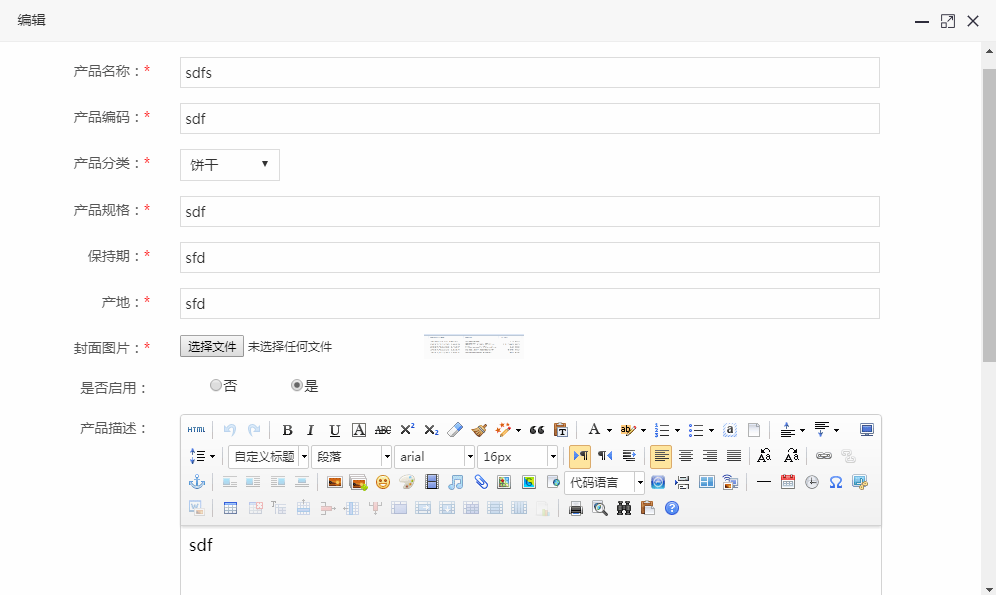这是后台管理系统最后一个功能,产品管理,它的接口与页面功能与上一章差不多。


获取产品列表接口

1 @get('/api/product/') 2 def callback(): 3 """ 4 获取列表数据 5 """ 6 # 设置查询条件 7 wheres = '' 8 # 产品分类id 9 product_class_id = convert_helper.to_int0(web_helper.get_query('product_class_id', '', is_check_null=False)) 10 if product_class_id > 0: 11 wheres = 'where product_class_id=' + str(product_class_id) 12 # 页面索引 13 page_number = convert_helper.to_int1(web_helper.get_query('page', '', is_check_null=False)) 14 # 页面显示记录数量 15 page_size = convert_helper.to_int0(web_helper.get_query('rows', '', is_check_null=False)) 16 # 排序字段 17 sidx = web_helper.get_query('sidx', '', is_check_null=False) 18 # 顺序还是倒序排序 19 sord = web_helper.get_query('sord', '', is_check_null=False) 20 # 初始化排序字段 21 order_by = 'id desc' 22 if sidx: 23 order_by = sidx + ' ' + sord 24 25 ############################################################# 26 # 初始化输出格式(前端使用jqgrid列表,需要指定输出格式) 27 data = { 28 'records': 0, 29 'total': 0, 30 'page': 1, 31 'rows': [], 32 } 33 ############################################################# 34 # 执行sql,获取指定条件的记录总数量 35 sql = 'select count(1) as records from product %(wheres)s' % {'wheres': wheres} 36 result = db_helper.read(sql) 37 # 如果查询失败或不存在指定条件记录,则直接返回初始值 38 if not result or result[0]['records'] == 0: 39 return data 40 # 保存总记录数量 41 data['records'] = result[0].get('records', 0) 42 43 ############################################################# 44 ### 设置分页索引与页面大小 ### 45 # 设置分页大小 46 if page_size is None or page_size <= 0: 47 page_size = 10 48 # 计算总页数 49 if data['records'] % page_size == 0: 50 page_total = data['records'] // page_size 51 else: 52 page_total = data['records'] // page_size + 1 53 # 记录总页面数量 54 data['total'] = page_total 55 56 # 判断提交的页码是否超出范围 57 if page_number < 1 or page_number > page_total: 58 page_number = page_total 59 # 记录当前页面索引值 60 data['page'] = page_number 61 62 # 计算当前页面要显示的记录起始位置 63 record_number = (page_number - 1) * page_size 64 # 设置查询分页条件 65 paging = ' limit ' + str(page_size) + ' offset ' + str(record_number) 66 ### 设置排序 ### 67 if not order_by: 68 order_by = 'id desc' 69 ############################################################# 70 71 # 组合sql查询语句 72 sql = "select * from product %(wheres)s order by %(orderby)s %(paging)s" % 73 {'wheres': wheres, 'orderby': order_by, 'paging': paging} 74 # 读取记录 75 result = db_helper.read(sql) 76 if result: 77 # 存储记录 78 data['rows'] = result 79 80 if data: 81 # 直接输出json 82 return web_helper.return_raise(json.dumps(data, cls=json_helper.CJsonEncoder)) 83 else: 84 return web_helper.return_msg(-1, "查询失败")
这个接口多了按产品分类id查询的条件,如果少了这个的话,直接将产品分类字段替换为产品字段变量就可以了。
大家可以看到这里的代码好像有点复杂。是的,这里要进行分页查询进行了分页处理,所以代码有点多,不过写了很详细的注释,只要你对python的基本语法、字典的处理理解,然后对之前工具函数那里按要求重写过测试用例,那么对阅读这段代码是没有什么大问题的。
下面再重新帮大家熟悉一下前面讲述过的工具函数
product_class_id = convert_helper.to_int0(web_helper.get_query('product_class_id', '产品分类id', is_check_null=False))
这是获取客户端(HTML)用AJAX提交上来的产品分类id接收处理,如果你认真看过前面工具函数内容的话,看到web_helper.get_query()这个函数应该会很熟悉,它就是获取GET方式提交值的接收函数,第一个参数是要接收的变量名称,第二个参数是这个变量的中文说明,第三个是在接收参数时,是否做非空判断,当前设置为这不是必填项。默认它为True,当为True时,如果客户端没有提交这个参数值,则系统自动会返回“xxx 不允许为空”,这个xxx就是第二个参数,也就是当前变量的中文说明,还有其他参数大家可以打看web_helper.py查看。
convert_helper.to_int0()这个函数,在前面工具函数第一篇中讲到的函数,它会将接收到的参数字符串转为int类型值,如果这个参数小于0时,会自动使用默认值0代替。
sql = 'select count(1) as records from product %(wheres)s' % {'wheres': wheres}
使用习惯ORM的朋友可能会不太习惯直接写sql语句,本系列第一部分主要面向没有什么基础的朋友,所以尽量不封装各种类和函数,这样大家直接看到内容会更容易理解。第二部分会教大家自己简单封装一个ORM,到时重构后重复代码就会减少一大半。
上面这行是获取当前查询有多少条记录的sql语句,熟悉python字符串替换的朋友应该会很熟悉,它会将字符串%后面的字典内容替代字符串中对应的键值,如果wheres值为空时,则替换空值,即将%(wheres)s这个键值替换掉。
python的字符串替换有多种方式,而这里使用字典方式来替换会让代码可读性更高,而且字典中各个值的位置不需要按固定方式摆放,不容易出错。
获取指定id的记录实体
1 @get('/api/product/<id:int>/') 2 def callback(id): 3 """ 4 获取指定记录 5 """ 6 sql = """select * from product where id = %s""" % (id,) 7 # 读取记录 8 result = db_helper.read(sql) 9 if result: 10 # 直接输出json 11 return web_helper.return_msg(0, '成功', result[0]) 12 else: 13 return web_helper.return_msg(-1, "查询失败")
这段代码比较简单,第6行使用的就是%s替换字符串方式,后面的元组(id,) 好像python3以后元组里不加逗号替换也没有问题,python2是一定要加的。
添加产品与修改产品接口

1 @post('/api/product/') 2 def callback(): 3 """ 4 新增记录 5 """ 6 name = web_helper.get_form('name', '产品名称') 7 code = web_helper.get_form('code', '产品编码') 8 product_class_id = convert_helper.to_int0(web_helper.get_form('product_class_id', '产品分类')) 9 standard = web_helper.get_form('standard', '产品规格') 10 quality_guarantee_period = web_helper.get_form('quality_guarantee_period', '保质期') 11 place_of_origin = web_helper.get_form('place_of_origin', '产地') 12 front_cover_img = web_helper.get_form('front_cover_img', '封面图片') 13 content = web_helper.get_form('content', '产品描述', is_check_special_char=False) 14 # 防sql注入攻击处理 15 content = string_helper.filter_str(content, "'") 16 # 防xss攻击处理 17 content = string_helper.clear_xss(content) 18 is_enable = convert_helper.to_int0(web_helper.get_form('is_enable', '是否启用')) 19 20 # 添加记录(使用returning这个函数能返回指定的字段值,这里要求返回新添加记录的自增id值) 21 sql = """insert into product (name, code, product_class_id, standard, quality_guarantee_period, 22 place_of_origin, front_cover_img, content, is_enable) 23 values (%s, %s, %s, %s, %s, %s, %s, %s, %s) returning id""" 24 vars = (name, code, product_class_id, standard, quality_guarantee_period, place_of_origin, front_cover_img, content, is_enable) 25 # 写入数据库 26 result = db_helper.write(sql, vars) 27 # 判断是否提交成功 28 if result and result[0].get('id'): 29 return web_helper.return_msg(0, '成功') 30 else: 31 return web_helper.return_msg(-1, "提交失败") 32 33 34 @put('/api/product/<id:int>/') 35 def callback(id): 36 """ 37 修改记录 38 """ 39 40 name = web_helper.get_form('name', '产品名称') 41 code = web_helper.get_form('code', '产品编码') 42 product_class_id = convert_helper.to_int0(web_helper.get_form('product_class_id', '产品分类')) 43 standard = web_helper.get_form('standard', '产品规格') 44 quality_guarantee_period = web_helper.get_form('quality_guarantee_period', '保质期') 45 place_of_origin = web_helper.get_form('place_of_origin', '产地') 46 front_cover_img = web_helper.get_form('front_cover_img', '封面图片') 47 content = web_helper.get_form('content', '产品描述', is_check_special_char=False) 48 # 防sql注入攻击处理 49 content = string_helper.filter_str(content, "'") 50 # 防xss攻击处理 51 content = string_helper.clear_xss(content) 52 is_enable = convert_helper.to_int0(web_helper.get_form('is_enable', '是否启用')) 53 54 # 编辑记录 55 sql = """ 56 update product 57 set name=%s, code=%s, product_class_id=%s, standard=%s, quality_guarantee_period=%s, 58 place_of_origin=%s, front_cover_img=%s, content=%s, is_enable=%s 59 where id=%s returning id""" 60 vars = (name, code, product_class_id, standard, quality_guarantee_period, place_of_origin, front_cover_img, content, 61 is_enable, id) 62 # 写入数据库 63 result = db_helper.write(sql, vars) 64 # 判断是否提交成功 65 if result and result[0].get('id'): 66 return web_helper.return_msg(0, '成功') 67 else: 68 return web_helper.return_msg(-1, "提交失败")
使用非get方式提交时,即使用post、put、delete等方式提交参数时,需要使用web_helper.get_form()函数来接收,这一点大家要注意,不然就会获取不到客户端提交的参数值
# 添加记录(使用returning这个函数能返回指定的字段值,这里要求返回新添加记录的自增id值) sql = """insert into product (name, code, product_class_id, standard, quality_guarantee_period, place_of_origin, front_cover_img, content, is_enable) values (%s, %s, %s, %s, %s, %s, %s, %s, %s) returning id""" vars = (name, code, product_class_id, standard, quality_guarantee_period, place_of_origin, front_cover_img, content, is_enable) # 写入数据库 result = db_helper.write(sql, vars)
新增记录时,容易出错的地方是参数中的%s与字段数量不匹配,这里大家要注意一下。另外,在insert语句的后尾最好加上returning id或returning * 返回新增记录值或整个记录实体,方便用来判断是否插入成功,如果返回这些内容的话,比较难判断数据库记录是否添加成功了
# 编辑记录 sql = """ update product set name=%s, code=%s, product_class_id=%s, standard=%s, quality_guarantee_period=%s, place_of_origin=%s, front_cover_img=%s, content=%s, is_enable=%s where id=%s returning id""" vars = (name, code, product_class_id, standard, quality_guarantee_period, place_of_origin, front_cover_img, content, is_enable, id) # 写入数据库 result = db_helper.write(sql, vars)
更新记录时,参数元组中记录要将记录的id值放进来,不然也会出现sql执行异常的问题,这个也是容易出错的地方。
删除记录接口
1 @delete('/api/product/<id:int>/') 2 def callback(id): 3 """ 4 删除指定记录 5 """ 6 # 编辑记录 7 sql = """delete from product where id=%s returning id""" 8 vars = (id,) 9 # 写入数据库 10 result = db_helper.write(sql, vars) 11 # 判断是否提交成功 12 if result: 13 return web_helper.return_msg(0, '成功') 14 else: 15 return web_helper.return_msg(-1, "删除失败")
前端代码大家自己可以比较一下上一章,看看有什么不同
非常感谢Sunshine-X 的提醒,在产品编辑页面的js中,添加了保存成功后jqgrid表格刷新代码(本人前端比较菜)
后面附上完整的项目代码
版权声明:本文原创发表于 博客园,作者为 AllEmpty 本文欢迎转载,但未经作者同意必须保留此段声明,且在文章页面明显位置给出原文连接,否则视为侵权。
python开发QQ群:669058475(本群已满)、733466321(可以加2群) 作者博客:http://www.cnblogs.com/EmptyFS/
